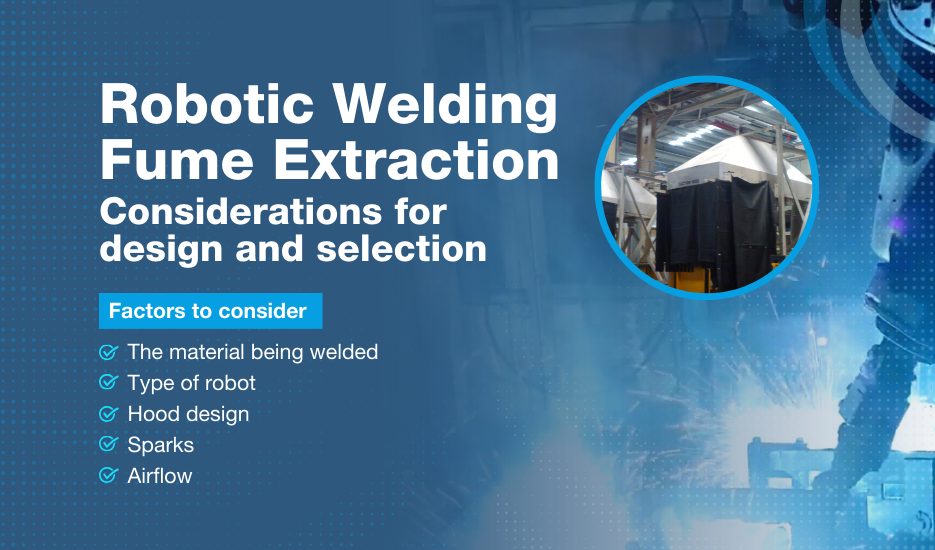The absence of an operator does not mean complete safety from pollution caused by robotic welding!
An operator may not be present in the robotic welding enclosure during the welding process. However, the fumes from welding still travel through the air and spread around the entire facility. In fact, since robots support large-scale manufacturing, they tend to undertake welding work on a large scale and thus generate a higher amount of welding fumes. Many peculiarities of robotic welding demand a specially designed fume extraction process.
What makes capturing robotic welding fumes challenging?
- Robots produce a far larger volume of dense welding fumes than manual welding
- Robots move quickly from one weld-part to another while the previous part is still emitting fumes
- Some robots may not have a fixed movement axis, which makes using on-torch extraction difficult
- An operator might still be present within the robotic welding cell, and their breathing zone must be protected
The core idea in capturing robotic welding fumes focuses on using the upward movement of dense smoke to one’s advantage. This is accomplished either by introducing capturing mechanism right near the welding torch (on-torch fume extraction), placement of hood over the welding arm, or by enclosing the entire robotic welding setup into a dedicated enclosure. Fume extraction and dust collection systems are then placed on top of this enclosure for effective fume filtration.
Factors to consider in robotic fume extraction
The material being welded
The material being welded is an important consideration from a compliance point of view. Many materials such as steel alloys, iron, or nickel alloys produce particularly harmful fumes when undergoing welding. The OSHA indoor air pollution regulations, for instance, issue stringent guidelines to control toxic dust emanating from materials such as galvanized or stainless steel. If the material to be welded is oily or corroded, it calls for downdraft filtering measures.
Fume extraction requirements vary according to the working metals and process parameters of your application.
Type of robot
The type and movement axis of robots determine the design and capacity of the fume extraction system. Rectilinear robots and articulating robots are the two most common types of welding robots used, along with single or dual wired robots. Rectilinear robots have a nearly uniform movement axis that creates a box-shaped working zone. On the other hand, articulating robots have rotating joints which are much more flexible. The working zone of these robots can change based on the pieces being welded.
Lastly, robots could either be used in 8-hour shifts, or they could go on 24X7 till the end of their service life. Your fume extraction system should be capable enough to tackle high level of fumes for such extended amounts of time.
In the case of single or dual-wire robots, the dual-wire robots produce more smoke, which impacts the sizing and design of the welding fume
Hood design
Robotic welding stations could either be provided with locally placed hoods or larger hoods for the complete area including loading and unloading stations. Capture velocity plays a critical role in containing the fumes. Similarly, if there is an operator, the vertical distance between the suction hoods and the point of generation along with the possibility of installing curtains are also important parameters to be considered to ensure effective extraction in order to safeguard the operator’s breathing zone.
The hood design is based on the type and amount of fumes being produced.
Sparks
Given the large scale of operations with robotic welding, the process creates a large number of sparks. The fume extractor system for robotic welding should be enabled with spark arrester technology to make sure that sparks do not come in contact with any combustible material.
The air filtration system should be equipped with prefilters/spark arresters for safety .
Airflow
There are two ways in which fume extraction can be done for robotic welding:
- Source capture: Done with specially designed fume extractor arms.
- Local capture: Done by placing a hood over the entire robotic welding setup.
While source capture or on-torch extraction is efficient, robots can move quickly from one welding part to another, while the previous part being welded is still emitting fumes. In the case of local capture, the airflow should be sized precisely to achieve an average minimum transport velocity. when this velocity is maintained, the enclosed welding setup will ensure effective containment and extraction of the generated fumes . The enclosed area should be protected from other airflow patterns created by cooling fans or HVAC systems that might disrupt the suction.
Conclusion
The fume extraction system should be designed considering factors as minute as the movement of robotic arms and the airflow patterns around the robotic welding setup.
Backed by more than a decade of experience and expertise, Span Filtration Systems has worked with some of India’s biggest automobile plants to capture their robotic welding fumes.
Span Filtration works closely with you to study your ventilation system and understand the unique needs of your application as well as workspace. We design and manufacture a wide range of air filtration solutions, ranging from centralized air filtration systems and dust collectors to compact mobile fume extractors. After a thorough study of your requirements, Span will design a system that will meet all your fume extraction requirements

